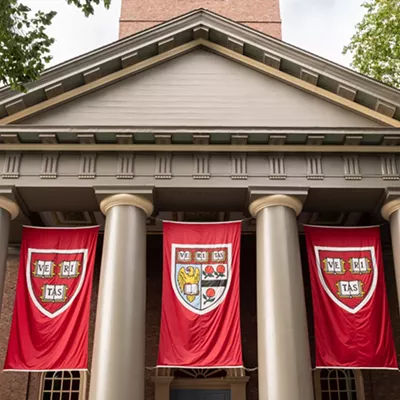Nothing gets your attention like a backed-up toilet, and that's just what public officials throughout the greater Spokane area are facing: the region's capacity to treat sewage is about to overflow. The city of Spokane's wastewater treatment plant, located off the Aubrey L. White Parkway on the Spokane River, has handled much of the region's needs until now. But with more people moving in and the Valley becoming more sewered, its capacity is reaching its limit. Seven days a week, the city plant treats 44 million gallons of sewage.
The problem worsens when it rains a lot. The city's stormwater system feeds into its sewers, and the plant can't accommodate both the rainwater from the storm drains and the sewage. When the plant is overwhelmed, untreated sewage is discharged directly into the river.
"We have had a couple of overflows within the last month, but the Department of Ecology says we can only have one per year, per discharge point -- we have 20 discharge points along the river," says Dale Arnold, wastewater management director for the city of Spokane. "Spokane needs more capacity to address those discharges into the river."
To alleviate the problem, the city was considering adding holding tanks by the existing plant to capture the overflow and store it until the plant is ready to treat it. But that option was recently taken off the table.
"We just found out that we can't do that -- we have to find a different solution," says Arnold. "We think it might be feasible to build not only a sanitary plant, but also a wet-weather plant to address stormwater and combined sewer overflows. We have had an engineering firm look at this requirement to build a facility that, rather than having 20 discharge points, would take them all to one plant. That plant would include not only all wet-weather overflow, but also the regional needs for all the sanitary requirements."
City officials now say this new plant, with a price tag expected to land anywhere from $200 million to $300 million, could be built large enough to handle all the region's sewage treatment and stormwater management needs.
But remember all those public policy discussions about how the city and Spokane County sometimes duplicate services needlessly? Well, just as the city is planning for its future needs, Spokane County has developed its own wastewater treatment plan. It's a plan that has been in the works for more than three years.
The county currently has a contract with the city to pump 10 million gallons through the city's wastewater treatment plant every day. But because of the rapid urbanization of once-rural areas and the many new sewer hookups in the Spokane Valley, estimates show that the county might reach its sanitary sewer capacity limit as early as 2007. So the county hit the drawing board and is now ready with plans for a brand-new wastewater treatment plant to handle its own needs.
Endeavoring not to build two major capital projects with the same purpose, the county looked at accepting the city's excess sewage in its new plant.
"The plant we are looking at constructing is a regional treatment plant. It would have the ability to treat flow from the city of Spokane, but it would be owned and operated by the county," says Bruce Rawls, Spokane County's utilities director. "We already submitted all these reports to the Department of Ecology; they should come back with approval this week."
The county's wastewater treatment plant alone would cost $74 million and pipelines and pump stations would be an additional $15 million -- adding up to about a $90 million project, says Rawls.
But the stormwater issue the city faces is not something the county planned for, and the facility it has on the drawing board would not be able to handle stormwater. So again, the two entities seem to be headed toward separate facilities.
And that's where the not-yet-incorporated city of Spokane Valley comes in (the offical date of incorporation is March 31). That city of 80,000 accounts for a huge share of the new sewage coming into the system, but it's unclear what Spokane Valley's elected officials want to do about it. What is clear, however, is that their decision will have major implications for the projects and will be a major issue for the new council from the day it takes control.
"The Valley and Liberty Lake don't know what to do yet," Rawls says, adding that Liberty Lake has a need for sewage treatment, too. "If the city of the Valley chooses not to utilize this plant, it may not be feasible to build the plant at all."
Still, with uncertainty mounting and time running out to get a plant underway before capacity is overwhelmed, public officials are hopeful that a regional solution can be reached.
Getting Started -- County Commissioner Kate McCaslin says the county already has spent hundreds of thousands of dollars studying the sewage issue, planning ahead to respond to the shortage of capacity.
"The sewer issue is very, very complex. There are tremendous long-term impacts," says McCaslin, adding that the county always has looked at the needs of all county residents. "We've always tried to position the plant geographically to accommodate the regional needs."
In 2000, the county's studies culminated in four alternative solutions, and after much research the county picked alternative number two: the construction of a plant to be located either where the old stockyards used to be (inside the city of Spokane) or north of Sprague, off Fancher Road (now inside the city of the Spokane Valley). Contrary to popular belief, a new plant does not have to be located on the river.
"I think the location would have to be determined by everybody's needs," says Arnold. "The county's [site] choices were all based only on sanitary needs, not on wet-weather needs, so there might be some other locations that we don't know about yet."
Though clearly realizing the need for a new plant, Valley city council members are trying to get caught up on the issue before committing their citizens to a new expensive project.
"We have questions about the sewer treatment plant," says Diana Wilhite, a councilwoman for the new city. "[The county] had already started down the path, but we want to talk to them about how they got to some of the assumptions that they did get to. We feel that we will have to get more active on that."
Valley City Councilman Steve Taylor agrees that the new city has missed out on the early negotiations, but he also says he's committed to continuing the sewering of the entire Valley.
"We are at a disadvantage as we haven't studied alternatives. We need a couple of months. There might be more options," says Taylor, adding that he wants the Valley to have a seat at the table for any further discussions. "Moving toward a regional sewer system is probably the most cost-effective way to go in the long run."
The city of Spokane's Arnold agrees. "I think we might as well build one big plant instead of having all these different plants," he says. "We should address the region's sanitary needs -- maybe include Liberty Lake, the Valley, the city and the county all on the same project. If the entire region would go together and cover the cost, it would also be cheaper per homeowner and per gallon to operate the plant."
But Rawls cautions that it may not be cost-effective to do everything at one plant.
"This new stormwater treatment system would take a lot to develop and study," he says of the city's problems with weather-related overflows. "To lump it all in the same plant may not be the best solution -- the city would have to study that."
In the end, decisions may be made based on how much it will cost to hook up to a new county or city plant. While most of the talk is about a regional facility, it's possible that as many as three facilities could be built (if, say, Liberty Lake and Spokane Valley teamed up to build a smaller, less expensive facility).
McCaslin says the county is bound by law to operate a sewage treatment plant on a break-even basis, but the city of Spokane charges a utility tax so it could potentially add money to its general fund with a new facility.
Arnold says the city is not trying to compete with the county to win the sewage treatment contract from the new city.
Regardless of who owns and operates the plant, the municipalities that hook up to it will have to pay to use it -- much like the county currently pays to use the city's plant. And because the county already has invested a lot in studying the project, McCaslin is eager to get a decision one way or the other. If the Valley hesitates to commit for too long, she says that without a way to handle sewage, a moratorium on new construction could result.
"It's important in our view that we proceed along the scheduled timeline," she says. "We could run out of capacity, and that would have big negative implications for the Valley."
New Technology? -- A new plant could also be built to take advantage of new technology. The county has, for instance, looked into one type of waste-water treatment that allows for the cleaned wastewater -- or effluent -- to be injected into the ground instead of returned to the river.
Since a new wastewater treatment plant in the Valley would be located immediately above the Spokane-Rathdrum Aquifer, some have objections to that technology. But Rawls says it may be a good solution.
"We will still be going out into the river, but we have evaluated other alternatives such as industrial reuse and aquifer recharge -- but they take a lot more study. We are not going to go with those options now," says Rawls. "People tend to get concerned when they hear about effluent going into the soil, but it's possible to treat wastewater to drinking water standards. If it's fit to drink, it's safe to pump into the aquifer."
Arnold, however, questions whether this technology is the right choice for the Spokane area. "The county had that technology listed as an option for a sanitary plant, and it's true in other states they have injected the effluent right into the soil," he says. "We should be protective of our sole-source aquifer."
It would seem that the region should be protective of the Spokane River as well. Because of the stormwater and overflow problem at the city's current facility, nearly 80 million gallons of raw sewage are still dumped into the river every year. The Washington State Department of Ecology has ordered the city to limit that amount to less than two million gallons a year by 2017.
Arnold says that a new plant applying the latest in wastewater treatment technology would be a huge benefit to the river.
"New technology would give a much cleaner effluent, even in the daily discharge," he says, "and we'd be able to adjust the flow a lot better than we can today at the current plant."
On Wednesday, representatives for the city of Spokane, Spokane Valley, Liberty Lake and Spokane County met for the first time to discuss the future of the sewer project.
Arnold was looking forward to the meeting: "We are not throwing anybody's plan away, but there may still be some locations and some options that we have not considered. I still think it would be best to get all the players together and have the entire region share the cost of construction."
Politically speaking, the new sewage treatment facility could be the first test of how the streamlined Spokane County, the new city of Spokane Valley and the city of Spokane can get along to solve a common problem. While the city and the county have sometimes failed to cooperate in the past, some have suggested that the presence of a group with no history -- the new Valley City Council -- can help provide a clean slate.
"There is a value to working together," says Valley Councilman Taylor. "This could save everybody a lot of money."
Ted S. McGregor Jr. contributed to this report.
Publication date: 02/27/03















